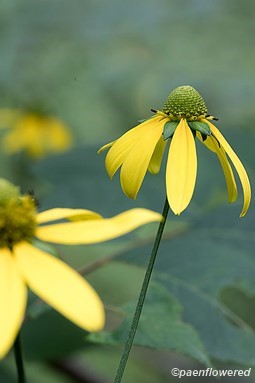Rudbeckia laciniata
Rudbeckia laciniata greenhead coneflower
This native perennial species resembles a sunflower but can be recognized by the knob-shaped central disk that is initially slightly rounded and green, but turns yellowish and then brown as it matures and becomes more elongated. Also distinctive are the 6-12 golden petal-like ray florets that droop downwards. The composite flower heads are 2.5 to 4 inches wide.
The lower leaves are deeply lobed into 3 or 5, or 7 irregular parts, while the leaves higher on the plant are small and elliptical. The stems are tall, branching and smooth. The plant grows 3-10 feet high, but most do not exceed 5 feet. This species is generally found in moist rich ground, swamps or thickets. It is especially common along the banks of small streams
Its range includes much of eastern and central North America and parts of the West. This species may form colonies as it spreads through the growth of its underground rhizome. The blooming period is July to September. It is also called the tall goldenglow, tall coneflower, or cutleaf coneflower. It is also called thimbleweed, though this name is also applied to several other species. The species is widely cultivated in ornamental gardens and for cut flowers. Numerous cultivated varieties have been developed. Traditionally young leaves were collected and then cooked as a potherb.
Habitat & Range
Common in floodplains, stream banks, and wet fields.
Present throughout the state.
| EMP: | FACW |
|---|---|
| NCNE: | FACW |
Phenology
Flowers July to September.
Plant Codes
S-rank: S5 (Secure)
G-rank: G5 (Secure)











Comments
Have you spotted this plant in your area? We'd love to hear about your experience! Share your comments or questions about the plant below. Comments are moderated before posting.